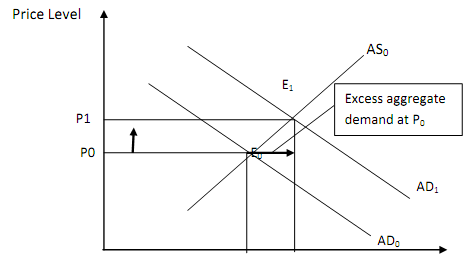Theories of Inflation:
Demand Pull Inflation: It describes a sustained increase in the general price level that is caused by a permanent increase in nominal aggregate demand. Simply, is can be viewed as an inflation that occurs as a result of increase in aggregate demand.
When aggregate demand exceeds aggregate supply at current prices, prices are pulled upwards to equilibrate aggregate supply and demand.

Figure: Demand Pull Inflation
In figure , an increase in aggregate demand from ADo to AD1 given the aggregate supply creates demand at P0. This causes price levels to increase from P0 to P1. A new equilibrium is established at point E1 with output at Y1 and at a higher price level of P1. The continuous repetition of this process will lead to a sustained increase in the price level with characterizes demand-pull inflation.